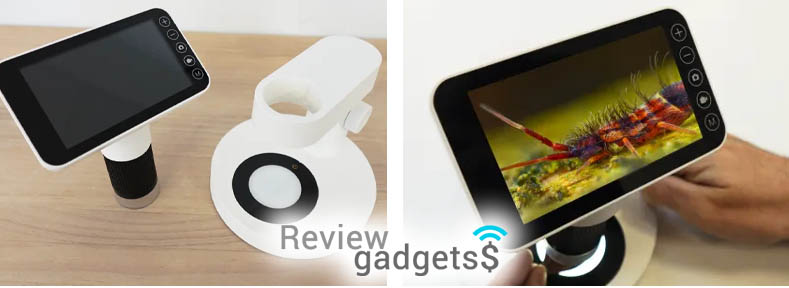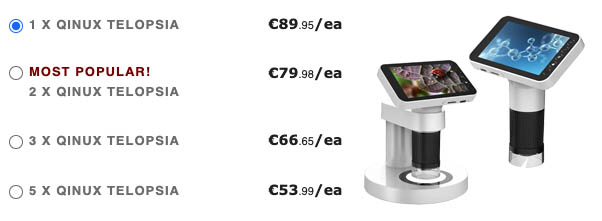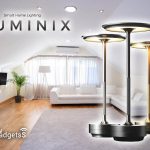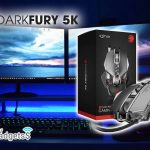I’ve always been fascinated by the tiny details the human eye can’t quite see: the hidden textures of a leaf, the fibers in a piece of fabric, the patterns on a coin’s surface. Until recently, seeing all that at home meant using lab-grade microscopes or imprecise kids’ toys.

So when I got the chance to test the Qinux Telopsia, a portable digital microscope with a full-color LCD and up to 1000x magnification, I put it through its paces in different settings: from an afternoon of exploring the garden with my nephews to a more serious materials check on my work desk.
What is Qinux Telopsia?
It’s a portable digital microscope designed to bring the microscopic world to anyone—no technical expertise or pro lab needed. Unlike traditional microscopes with eyepieces, Telopsia features a 4-inch color TFT screen, so you can observe comfortably and share what you’re seeing with others at the same time. It also includes a long-lasting rechargeable battery, adjustable LED lighting, and the option to save photos and videos to a microSD card.
The best part is its 2-in-1 design, which makes it truly versatile: use it handheld outdoors, or set it on its detachable base to turn it into a stable desktop microscope.
Design and First Impressions
The Qinux Telopsia looks solid and modern. It weighs just over half a kilo, making it easy to carry in a backpack. The high-quality plastic shell feels sturdy and durable. Touch buttons on the base and the screen respond quickly with no lag—essential when you’re tweaking zoom or lighting in real time.
Having two adjustable LED light sources is a game-changer: one in the main body and another in the base. This lets you view both opaque samples (like coins or insects) and transparent ones (onion skins, crystals, textile fibers) with impressive clarity.

How It Performs in Practice
Powering up and getting started takes under a minute. Just place an object under the lens, adjust the working distance, and set the lighting. The screen gives you a clear, crisp image right away—no complicated calibration needed.
In my tests, the usable magnification ranges from about 50x up to 1000x, which is enough to admire leaf veins and even see basic plant cells. When you connect it to a computer via USB-C, it can double as a desktop camera or “science webcam”—perfect for projecting your observations onto a big screen during a class or presentation.
Educational and Family Uses
One thing that really surprised me was how well it fit into a family setting. My nephews spent hours exploring insects, rocks, and everyday objects. The color screen avoids the discomfort of squinting through tiny eyepieces, turning the whole experience into something fun and shareable.
For educators, Qinux Telopsia opens the door to more engaging classroom experiments. A teacher can show a specimen to the entire class in real time by projecting the feed, and students can handle it without worrying about “breaking” delicate lab equipment.
Image Quality and Recording
The built-in 1-megapixel sensor captures fine details with precision. While it won’t compete with high-end lab microscopes, the quality is more than enough for education, hobbies, and small research projects. Being able to record photos and videos directly to a microSD card (up to 32 GB) adds huge value: document findings, make comparisons, or share them on social media.

Battery and Runtime
Telopsia packs a 1200 mAh rechargeable battery that, in my testing, delivered about three hours of continuous use with lighting at 70%. That’s plenty for short exploration sessions, and the best part is it recharges in just over an hour via USB-C. The battery life makes it truly portable—ideal for field trips and pop-up workshops.
Key Advantages
- Up to 1000x magnification, ideal for a wide range of objects.
- 4-inch color TFT screen—no eyepieces required.
- Adjustable dual LED lighting for crisp viewing in any setting.
- Photo and video recording, turning it into a documentation tool.
- Portable design with detachable base, great for home use and more professional observations.
- PC compatible, multiplying its educational and presentation uses.
Price and Special Offers
Want to explore a universe of details invisible to the naked eye—without building a home lab? The Qinux Telopsia launches with a promotion offering 50% off and free shipping. Thanks to this deal, you can get it for €89.95 (promo price) instead of €179.95 , while stocks last.
This is your chance to pick up a fully self-contained digital microscope—with a 4-inch color TFT screen, rechargeable battery, and microSD recording—that lets you explore coins, textile fibers, insects, or transparent slides with up to 1000x magnification.
Activate the 50% discount via this link
How to Buy
- Check availability on the official website via this link.
- Choose how many Qinux Telopsia units you want.
- Enter your shipping and payment details to complete a secure purchase.
- Enjoy the limited-time promotion and have your digital microscope delivered to your door.
Purchase Guarantee
Your Qinux Telopsia order is protected by a 30-day satisfaction guarantee. If it doesn’t meet your expectations, you can request a hassle-free refund within that period. It also includes a manufacturer’s warranty for peace of mind.
What Other Users Say
With over 1,500 buyer reviews and an average rating of 4.7 out of 5 on TrustScore, Qinux Telopsia stands out for its image quality, intuitive operation, and versatile 2-in-1 design (handheld and desktop). Here are a few user experiences:
Anna Parker ★★★★☆ (4.6/5)
“I use it in class with my elementary students. The built-in screen means they don’t have to take turns at an eyepiece. We project via USB-C to the classroom display so everyone sees leaf veins or coin details at the same time. Super practical.”
David Mitchell ★★★★☆ (4.8/5)
“I collect coins and stamps. The adjustable dual lighting makes a big difference on reflective surfaces—you can see relief and micro-details without glare. The detachable base adds stability for tack-sharp photos.”
Emily Carter ★★★★★ (4.9/5)
“My kids spend afternoons looking at clothing fibers, salt crystals, and insect wings. It’s plug-and-play—no weird calibration. The battery lasts for multi-hour sessions and the microSD photos are perfect for their projects.”
Peter Williams ★★★★☆ (4.7/5)
“I work with prototypes and PCBs. As a USB desktop camera it’s excellent for documenting solder joints and tiny cracks. It’s not an expensive lab rig, but for the price and battery life it more than delivers for day-to-day work.”
Take advantage of this promo and grab your Qinux Telopsia to study textures, patterns, and micro-structures—with no cables, no eyepiece, and no need to rely on a PC. Explore, document, and share your discoveries with a single device.
Activate the 50% discount via this link
Comparison with Other Digital Microscopes
You’ll find similar digital microscopes from brands like Celestron or Dino-Lite offering comparable features. However, most of them need a direct PC connection to work—or a smartphone, as with the Qinux ZoomZip—and they don’t include a built-in screen. That’s where Telopsia stands out: it offers total autonomy with onboard screen, battery, and storage—no extra accessories needed. And its promo price (€89.95) is competitive against models that easily top €200.
Who Is It For?
- Kids and families who want to discover science through play.
- Teachers looking for a practical, hands-on classroom tool.
- Hobbyists and collectors who want to examine coins, minerals, or stamps in detail.
- Amateur researchers who need a lightweight, versatile device for quick observations.
It won’t replace a laboratory microscope in an advanced scientific setting—and it isn’t trying to. Its value lies in making microscopic exploration accessible to a much wider audience, in a format that’s easy to use and easy to love.
Frequently Asked Questions (FAQ)
What magnification can I realistically expect?
The practical range is roughly 50x to 1000x, enough to view leaf venation, textile fibers, salt grains, or basic structures on plant slides. Perceived magnification varies with working distance and sample size.
Do I need an app or a computer to use it?
No. Qinux Telopsia is fully standalone: power it on, place the sample, and view it on the 4-inch TFT screen. With a USB-C cable you can connect it to a PC to project, capture from the computer, or use it as a “science webcam.”
How long does the battery last?
Typically around 3 hours with lighting at about 60–70%. Actual runtime varies by brightness and usage. It recharges in just over an hour via USB-C.
Can I record photos and videos of what I see?
Yes. It supports direct recording to a microSD card (up to 32 GB). Ideal for documenting findings, making comparisons, or sharing content in classes and presentations.
Is it suitable for both opaque and transparent samples?
Yes. It has dual, adjustable LED lighting (in the body and in the base) so you can adapt the light for reflective surfaces (coins, minerals, insects) and translucent slides (onion layers, thin petals, fibers).
Activate the 50% discount via this link
Is it suitable for children?
Yes, with adult supervision. The screen replaces eyepieces, so several kids can watch at the same time and it’s more ergonomic. Teach them to handle the stand and lens carefully.
What’s in the box?
The Qinux Telopsia microscope body with built-in screen, detachable desktop base, USB-C cable, user manual, and basic cleaning/adjustment accessories (may vary by batch). A microSD card is not always included.
Which systems is it USB-compatible with?
It works as a standard UVC camera with most modern Windows and macOS systems. In the vast majority of cases, no special drivers are required.
Can I use it for video calls or presentations?
Yes. Connect via USB-C and select it as the video source in your conferencing or capture software. Great for workshops, live demos, and online training.
What resolution does the sensor offer?
It uses a 1 MP sensor optimized to capture micro-details with solid sharpness. It won’t rival premium lab gear, but it’s far beyond basic “toy” microscopes and easily covers educational and hobby use.
Is it fragile or does it need special care?
The PC plastic chassis is robust. We recommend cleaning the lens with a soft cloth, storing the unit dust-free, and avoiding drops. The LED lighting and electronics require no maintenance beyond occasional cleaning.
Conclusion
After several days of use, I can say that Qinux Telopsia is far more than a neat gadget: it’s an educational, fun, and surprisingly useful tool. With its color screen, long battery life, and built-in recording, it opens a window onto an invisible world once reserved for labs.
For under €90 with free shipping and 50% off, it’s hard to find a digital microscope this complete, self-contained, and versatile. If you’ve ever dreamed of seeing what your eyes can’t—or want to gift a unique science experience—this little device can spark big discoveries.






